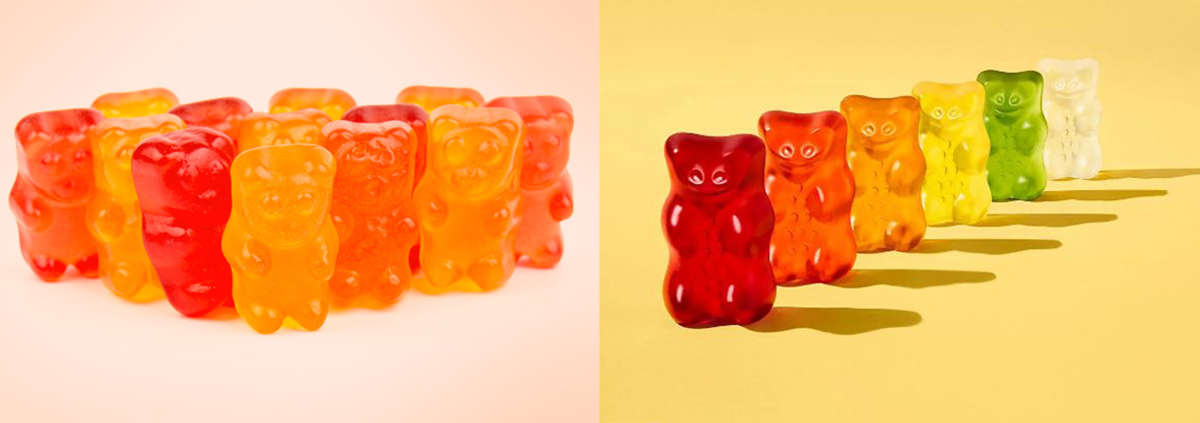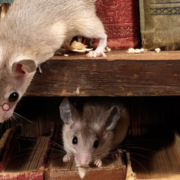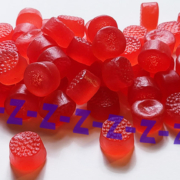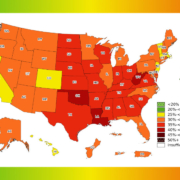Supplements and Safety for Kids
The real issue with melatonin and children is not with the actual overdose. Of the 260,000 calls to the U.S. Poison Control Centers, 218,000 were about kids under five years old. Kids will put just about anything in their mouths, especially those younger than five. The issues as I see them are the delivery system and access. This doesn’t apply to just melatonin but to all dietary supplements.
The Delivery System Dilemma
Gummy vitamins are chewable vitamins with taste, flavor, color, shape, and size similar to gummy candies. Therein lies the problem. That’s the way kids see them: as gummies. And neither the candies nor the supplements are going away any time soon.
Even after years of dispensing gummy supplements to Riley, if you gave me two red bears, I’d find it hard to tell the vitamin from the candy. In the image above, it’s vitamins on the left and candy on the right, but other than the green and clear bear candies, they look alike. Some are shaped more like gumdrops, but multivitamins are often bears and look just like their candy counterparts. At seven, Riley knows which gummies he gets when, how many of each, and what the jars look like; if your kids and grandkids are younger, you’ve got a lot of teaching ahead of you. It seems helping kids learn the difference between packages is another element of keeping them safe.
The global gummy vitamins market size was estimated to be valued around $5.9 billion in 2020 and is projected to reach $10.6 billion by 2025. According to Market and Market, Millennials prefer consuming these gummies due to factors such as busier lifestyles, rising disposable incomes, growing awareness regarding preventive healthcare measures, and maintaining better health. But don’t blame the Millennials; every age group has seen increases in the use of gummies as dietary supplements. They’re easier to use for people who find it hard to swallow whole pills, and let’s face it, they’re just more fun.
Chewables and powders are on the increase as well. Those shakes you make? Check the labels to see if they contain vitamins or minerals. Phytonutrients from whole plants are fine, but some powders add nutrients and herbs that may not be safe for children in high quantities.
Out of Sight Is Safe
I think the key issue is that kids need to be taught that gummy dietary supplements are not candy. Even more so, they have to be kept out of reach of children, not on the counters where they’re more convenient for adults (and for kids). Multivitamin-minerals, omegas, melatonin, and others have push-tops that can challenge even adults. Still it would be best to keep them as high as possible and out of reach, especially if you also use the adult versions.
For most kids, eating too many supplement gummies may result in an upset tummy at most, but some vitamins and minerals can be toxic to children, especially under five. Everyone with small kids underfoot should know the number for the U.S. Poison Control Center for many reasons: (800) 222-1222; registered nurses and pharmacists are there to help 24/7. Most other countries have similar help available.
The Bottom Line
I think the promotion of the CDC’s Morbidity and Mortality Weekly Report melatonin article was done poorly. Pediatric melatonin ingestions are not all poisonings as the article implied. However, delivery systems and child access can be problematic, and that should have been the focus. Every news outlet likes sensational headlines, but if the writers had actually read the paper, which is free to the public, instead of reading comments by the paper’s authors, they’d not have been so sensational in their presentation. Or maybe they would have. Who knows?
Now you know the real deal about the safety issues surrounding dietary supplements for kids. If you want to know more about the safety of melatonin for children as well as comments by the authors, listen to the latest Straight Talk on Health by becoming a Member or Insider.
What are you prepared to do today?
Dr. Chet
Reference: Gummy vitamins Market. Market and Market, 2020.







